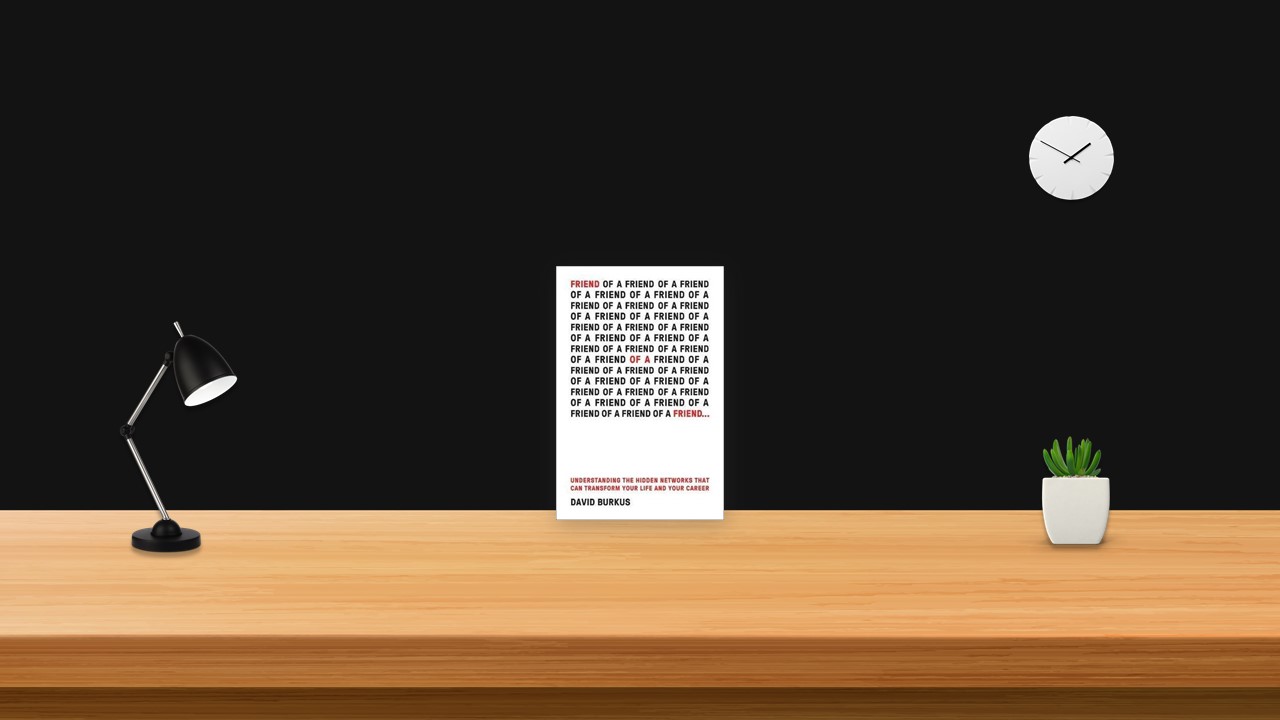Why Your Old Friends Are Better Than Your New Friends
We tend to act as if our closest friends are our biggest assets. While that may be true for social support or for trusted information, it’s not so true when it comes to opportunity. Research shows that our biggest opportunities and best sources of new information actually come from our “weak ties” or “dormant ties”—our connections with people we don’t see often or haven’t spoken to in a long time. This means that if we want to learn something new or make a job change, reaching out to our old friends is a better move than keeping it “just between friends” by connecting only with the people we’re closest to now.
The biggest implication of the strength of weak and dormant ties is that we ought to fight our impulses. When we have a career setback, for example, we tend to tell only a close circle of friends who may or may not be able to help (most likely not), and then we take to blindly responding to job postings online or calling headhunters. Instead, we ought to go to our weak and dormant ties, tell them our story, and see what opportunities they can steer us toward.
Even better is to start a regular practice of reengaging with your weak and dormant ties. So here’s a weekly routine to get you started:
- List six to ten work colleagues with whom you used to have a strong relationship but who have since fallen by the wayside—include, at a minimum, those colleagues with whom you haven’t had an in-depth conversation in two years.
- Randomly select one person from the list. Roll dice or flip a coin if you have to, then email or call with an invitation to chat in person or via phone call.
- Don’t set an agenda. Don’t say you are looking for something specific. Just say you would like to reconnect. During a free-flowing conversation, however, you are likely to talk about work matters, problems, opportunities, etc. Make a note of these and follow up anywhere you could help or might need help.
Why It Really Is a Small World After All
We often think of networks as just a collection of connections we have—big or small, good or bad—and tend to sort these folks by their usefulness to the situation at hand. However, research shows that we are all so closely connected that this is a bad way to frame our networks. The truth is that we are all one big network, and the people who succeed are not the ones with the best collection but the ones who can see and navigate their network best.
If you can’t find any alumni network, trade association, or professional group through which to reconnect, then why not start your own? It doesn’t have to be elaborate. Simply reaching out to former coworkers and inviting them to have lunch or call just to catch up may be enough to kick-start an alumni movement. Interestingly, this is exactly what happened at Procter & Gamble. Former employees started a nonprofit alumni club that grew to be so influential that P&G chose to deliberately partner with them to serve all former P&G employees and their community. Now the P&G alumni network rivals that of more deliberate efforts like those of universities and consulting firms.
Why Climbing the Corporate Ladder May Be the Worst Path to the Top
We often think that the way to success is to just stay in our lane, climb up the corporate ladder or become an expert in our field, and focus on meeting ever more powerful people inside our industry or sector. Research into networks reveals that, surprisingly, the most connected people inside a tight group within a single industry are less valuable than the people who span the gaps between groups and broker information back and forth. This finding has implications for how we manage our careers and how we manage our organizations.
There is real value to be captured by bringing two unconnected groups together. You might not always be able to see that value right away, but as you become the broker who fills the structural holes, you will have a greater chance of finding the right opportunity. Given the importance of this role, it’s vital to first know whether or not you are currently a broker in your local network or, if not, who the actual brokers are.
Why You Need to Spend Time in Clusters, but Not Too Much Time
While much of modern business writing warns about the dangers of silos, the truth is more complicated. Research suggests that, indeed, becoming too siloed can be damaging to businesses and careers, but at the same time, not being siloed enough can be just as damaging to growth. The most successful individuals know that they need clusters of similar people who can help them develop and grow, but also that they can’t spend all of their time inside of clusters. They oscillate between being part of a silo and reaching out into the broader network.
If you don’t have a team that you can interact with briefly but regularly, it’s time to just start your own. For the first few meetings, you may need to act as a moderator to keep everyone on task. Likewise, you may find that the questions you ask change or the overall agenda is revised. That is okay. The important thing is that you’ve found and built a community that you can turn to regularly for growth and accountability. And bonus points if you can come up with a clever name like the “The Inklings” for your cluster.
Why the Best Teams Don’t Stay Together Long
Knowing that clusters and collaboration are important, we can easily assume that the best teams are those that have stuck together for a long time—those that have performed well again and again. But research offers a different lesson, revealing that many of the most successful teams are successful only because they are temporary—they meet for a time and then disband, with some members going to other teams. In the end, having a large network and a tight-knit team isn’t as valuable as having a loose network and temporary teams.
So many of us approach building a network by searching for trusted individuals with whom we’ll work forever. We tend to assume that the best teams are ones that have held fast together for a long time. But the hard research on the nature of teams and networks suggests that the best and most productive teams are only temporary.
Why Some People Really Do Know Everybody
When we look out at our network and the networks of others, it’s easy to assume that all our networks are around the same size. Research into human networks, however, reveals that some people have drastically more connections than whatever would be an average—they are super-connectors. But the evidence also suggests that most of us have the ability to grow our network large enough to become a super-connector. We just need to grow it carefully.
Why the Most Connected People Tend to Stay That Way
We tend to look at super-connectors, with their large-scale networks, and marvel at how much work it must take to build and maintain such a collection of contacts. But research reveals a surprising fact about connections: they get easier to make over time. The more connections you have, the more likely you are to make new connections. So building a valuable network might seem like a lot of work now, but eventually it will become effortless.
Dinners and other large events can be a great way to scale your network of contacts faster. Unlike grabbing a quick coffee with just one or two people, sharing a meal allows you to connect to a dozen or more people at once for several hours, building more and deeper connections. In addition, depending on the structure of the dinner, it can be a way to leverage preferential attachment no matter how small your network is.
You can host dinners (or lunches) in your own city or your own home, or you can regularly plan to host a dinner when you are traveling to connect with old contacts (and make new ones) in each city you visit. To make sure your event is a success, there are a few things you have to consider:
- The size: At a minimum, invite six people.
- The guests: Ideally, you want a good mix of old friends and new contacts.
- The location: Your home is a great choice, as it’s personal and comfortable enough to encourage people to linger.
- The frequency: If it’s your first event ever, don’t worry so much about this one. However, once you try it and it works, you need to think about how frequently (weekly, twice a month, monthly, quarterly) you would like to hold events. Just one time is not enough to leverage preferential attachment.
Why the Best Networking Events Have Nothing to Do with Networking
The most common association we have with connections and networking is networking events, those special places and times dedicated to meeting new people. As with homophily, however, we are most likely to use our time at such events to connect with people we already know or people who are similar to ourselves. Networking events don’t bring us truly new contacts. Instead, research suggests, we are better off engaging in activities that draw a cross-section of people and letting those connections form naturally as we engage with the task at hand.
These shared activities draw a more diverse group of people and create stronger bonds among participants. Here are a few types of shared activities to start participating in:
- Community service programs
- Recreational sports leagues, martial arts, or hobby clubs
- Nonprofit boards or committees
- At-work special projects teams
- Churches, synagogues, mosques, and other faith-based groups
Final Word
We don’t have a network; rather, we’re embedded inside a massive network that we must learn to navigate. Doing so requires paying attention to who is in your network and recognizing that how your network works matters for issues much larger than just finding that next client or landing that next job. Social networks aren’t just transactional, and they never were. They’re developmental. Your network is influencing you, and so you better begin influencing your network. Navigating your network deliberately—making choices about who your friends are and being aware of who is a friend of a friend—can directly influence the person you become, for better or worse.
Your friend of a friend is your future.


